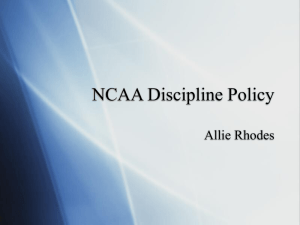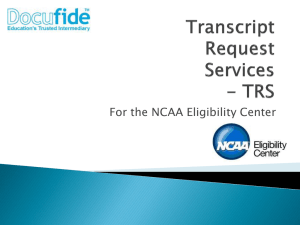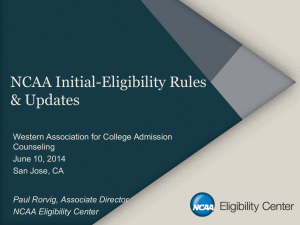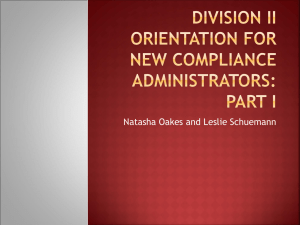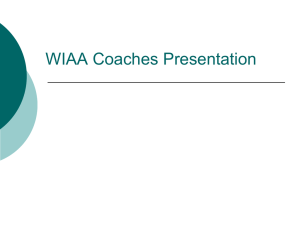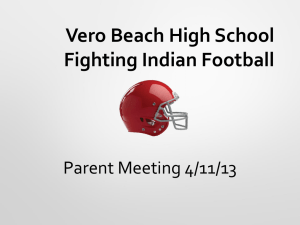NCAA PowerPoint Presentation
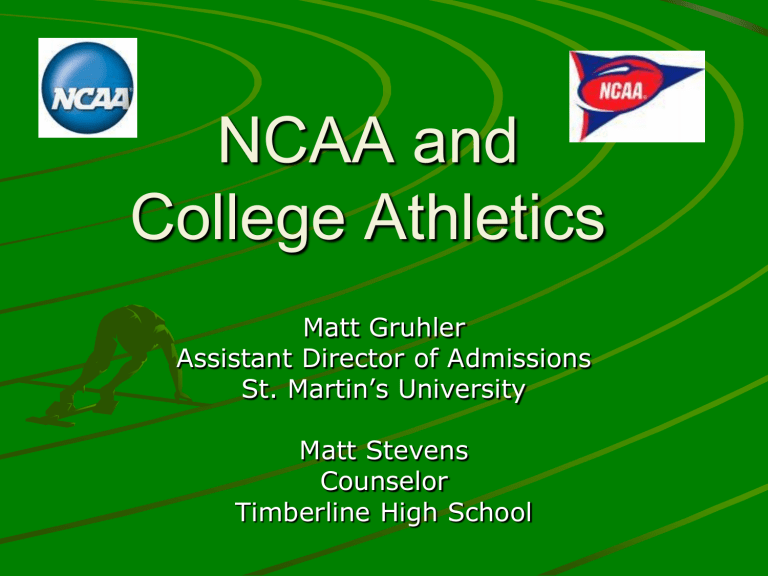
NCAA and
College Athletics
Matt Gruhler
Assistant Director of Admissions
St. Martin’s University
Matt Stevens
Counselor
Timberline High School
General Overview
NCAA
– Divisions I, II, III
Recruiting Process
NCAA Initial-Eligibility Center
– Formerly the NCAA Clearinghouse
NCAA Divisions
Division I
– 329 schools
– FBS, FCS, and non-football
– Offer Athletic
Scholarships
– More scholarships available
– Have more sports required
(7-m, 7-w)
– Attendance requirements
(FBS teams)
Division II
– 282 schools
– Offer Athletic scholarships
– More restrictions on # of scholarships
– Require certain
# of sports (5m, 5-w)
Division III
– 422 schools
– No athletic scholarships
– Require certain
# of sports
(5-m, 5-w)
– Focus is on participation and enhancing
SA experience
Alaska
Oregon
Oregon St.
University
Portland
St.University
University of
Oregon
University of
Portland
Pacific Northwest
D-1 Schools
Idaho Montana
Boise St. University
Idaho St. University
University of Idaho
Montana
St.University
University of
Montana
Washington
Eastern Wa
University
Gonzaga University
Univ. of Washington
Washington St.
Univ.
(from NCAA.org)
Northwest/Rocky Mountain
D-2 Schools
Colorado
Adams State College
CO Christian
University
CO School of Mines
CO State Univ. –
Pueblo
Ft Lewis College
Mesa State College
Metropolitan State
College
Regis University
Univ. of CO – CO
Springs
Univ. of Northern CO
Western State College of CO
New Mexico
Eastern NM University
NM Highlands
University
Western NM University
Arizona
Grand Canyon
University
Alaska
Univ. of AK –
Anchorage
Univ. of AK –
Fairbanks
Washington
Central WA University
Seattle Pacific
University
Seattle University
St Martin’s University
Western WA
University
Oregon
Western Oregon Univ.
Idaho
Northwest Nazarene
Univ.
(from NCAA.org)
Northwest/Rocky Mountain
D-3 Schools
Washington
Pacific Lutheran
Univ.
Univ. of Puget
Sound
Whitman
University
Whitworth
University
Oregon
Eastern Oregon
Univ.
George Fox
University
Lewis and Clark
College
Linfield College
Pacific University
Willamette
University
Colorado
Colorado College
(from NCAA.org)
NAIA
National Association of Intercollegiate Athletics
Montana
Founded in 1937, the NAIA has 283 schools and
Thousands of athletes.
Carroll College
Univ. of Great Falls
MSU-Northern
Montana Tech
Washington
The Evergreen State College
Northwest University
Univ. of Montana-Western
Rocky Mountain College
Idaho
Albertson College
Lewis & Clark St
Oregon
Cascade College
Concordia University
Corban College
Eastern Oregon U
Oregon Inst. of Tech
Southern Oregon U
Warner Pacific Coll
Estimated Probability of
Competing Beyond H.S. Level
Student/Athlete Football
HS Student/Athlete
HS Senior
Student/Athlete
NCAA Freshman
Positions
NCAA Athletes
Drafted
Percent HS to NCAA
Percent HS to
Professional
983,600
281,000
16,200
250
5.8
0.09
Men’s
Basketball
549,500
157,000
Women’s
Basketball
456,900
130,500
4,500 4,100
44
2.9
0.03
32
3.1
0.02
The Myth of the Full $ Ride
Sport UW WWU SPU SU SMU
Men’s BB 13
Women’s BB 15
Men’s Soccer 9.9
Volleyball 12
5
3
9 8 10
6 7.35
10
6
4
5
6
(stats from
HECB)
6
6
7
4
(stats from
HECB)
-Cost of Attendance at State schools vs Private schools affects the $$$ amount of your scholarship
The Recruitment Process
There are two reasons high school students do not get recruited:
1.
They are not good enough.
2.
The right college coaches who may need their talent have not heard of them.
Three Step Process
Assess Athletic Ability
(high school or club coach)
Identify Appropriate Colleges
(find the right “fit”)
Communicate with the college coach
(phone, email or letter)
Student Questions for their High
School/Club Coach
How good do you think I am?
What level and size school do you recommend?
What colleges and college coaches do you know?
Do you have any search suggestions?
Might I have problems at the collegiate level?
Could you prepare a letter of recommendation?
Would you be willing to contact college coaches on my behalf?
Recruiting Process
Prospective Student Athlete
– Anyone who has started classes for the 9 th grade
Sophomore year (D1 only)
– Camp brochures, questionnaires
– No phone calls from coaches
– No off-campus contact by coaches
Recruiting Process (cont.)
Junior Year
– Recruiting Materials (includes emails)
Sept. 1st (DI/DII)
– MBB – June 15
DIII – anytime
– Phone calls
Men’s Basketball
– 1x per month starting June 15 th thru July 31st after his Junior year
Women’s Basketball
– 1x per month in April, May, June 1-20, June 21-30
– 3x in July (no more than 1x per week)
Football
– 1 call from April 15 th thru May 31 st
No limit on # of calls or when made (DIII)
– No off-campus contact by coaches
– Register w/NCAA Initial Eligibility Center (summer after junior year)
Recruiting Process (cont.)
Senior Year (D1 and D2)
– Recruiting Materials
– Telephone calls
D1 – varies per sport
– FB (1x week after 9/1)
– MBB (2x week starting 8/1)
– WBB (1x week starting 8/1)
D2 – 1x week starting June 15 th
– Off Campus Contacts
D1 (MBB – 9/9, WBB – 9/16, FB – 11/27)
D2 (All Sports – 6/15)
D3 (All Sports – after Junior year)
Recruiting Process (cont.)
Text Messaging
– Banned at all levels now
Unofficial Visits
– Unlimited #, at your own expense
Official Visits
– Starting 1 st day of class senior year
– Can be paid for by school
Travel, lodging, entertainment, etc…
– Limits to the # of visits
1 per school
5 visits total
NCAA Initial-Eligibility Center
Formerly NCAA Clearinghouse
– Oversight of certification, NLI’s, waivers, amateurism, and anything to do with initial enrollees
All DI/DII student athletes must apply
Decides freshman eligibility www.ncaaclearinghouse.net
NCAA Initial-Eligibility Center (cont.)
Main Components
– High School Graduation
– Core Course Completion
– Minimum GPA in Core Courses
– Test Scores
– Amateurism
NCAA Initial-Eligibility Center (cont.)
High School Graduation
– Official transcripts with proof of graduation must be sent
– GED tests can also be used to satisfy graduation requirement
NCAA Initial-Eligibility Center (cont.)
Core Course Completion
– Classes must appear on high school’s approved classes list (48-H form)
– Only 9 th -12 th grades used
– Summer school after 12 th grade
DII can
DI can’t
– College courses can count
Must be accepted by high school
Meet all core course requirement
Appear on transcript (DI), college transcript should be sent into Initial Eligibility Center as well
NCAA Initial-Eligibility Center (cont.)
D1 = 16 core
– 4 english, 3 math, 2 science, 1 addt’l
(from english, math, science), 2 social science, 4 extra from any of those areas
D2 = 14 core (tuning to 16 in 2013)
– 3 english, 2 math, 2 science, 2 addt’l
(from english, math, science), 2 social science, 3 extra from any of those areas
NCAA Initial-Eligibility Center (cont.)
Core Course GPA Requirement
– Best grades in 14 or 16 core classes
– Lowest scores accepted = D
– Pass/Fail classes can count
Assigned school’s lowest passing grade
– D2 = straight 2.00 or better
– D1 = sliding scale based on Test Score
NCAA Initial-Eligibility Center (cont.)
Test Scores
– Before full-time enrollment
– No limit on # of times taken
– Taken on a national testing date
– May use best subscores on different tests
– Scores MUST come directly from testing agency (code 9999)
– Writing component is not used
NCAA Initial-Eligibility Center (cont.)
Test Scores
– D2 = 820 (SAT) and 68 (ACT)
– D1 = sliding scale with Core GPA
Rule of thumb = for every .025 GPA increase, test score requirement goes down 10 (SAT) and 1 (ACT)
2.00
1010 86
2.20
940
2.40
860
2.50
820
2.60
780
2.80
700
79
71
68
64
57
2.90
660
3.00
620
3.10
580
3.25
490
3.40
460
3.55
400
54
52
49
44
42
37
What should I be doing?
JUNIOR YEAR
– Register with the eligibility center.
– Make sure you are still on course to meet core-course requirements (verify you have the correct number of core courses and that the core courses are on your high school's 48-H with the eligibility center).
– After your junior year, have your high school guidance counselor send a copy of your transcript. If you have attended any other high schools, make sure a transcript is sent to the eligibility center from each high school.
– When taking the ACT or SAT, request test scores to be sent to the eligibility center (the code is "9999").
– Begin your amateurism questionnaire.
What should I be doing? ( con’t)
SENIOR YEAR
– When taking the ACT or SAT, request test scores to be sent to the eligibility center (the code is "9999").
– Complete amateurism questionnaire and sign the final authorization signature online on or after April 1 if you are expecting to enroll in college in the fall semester. (If you are expecting to enroll for spring semester, sign the final authorization signature on or after October 1 of the year prior to enrollment.)
– Have your high school guidance counselor send a final transcript with proof of graduation to the eligibility center.
NCAA Clearinghouse Eligibility
Process
Go to www.ncaaclearinghouse.net and click “prospective student athlete” link.
Go to the “Domestic Student Release” link and fill out the form.
Print two copies of the “Student Release Form”.
Give Copies #1 and #2 to guidance office (copy #1 is sent with 6 th semester transcript while copy #2 is sent with final transcript upon graduation).
Have ACT/SAT scores sent to the Clearinghouse (#9999)
NCAA Initial-Eligibility Center (cont.)
Qualifier Partial Qualifier
– Met all requirements
– Practice
– Compete
– Graduated
– Met either test score or GPA, but not both
– Travel
– Receive athletic scholarship
– Only in D2
– Practice
– Receive athletic scholarship
– No competition, and no travel
Non-Qualifier
– Did not graduate
– Did not meet # of required core courses, GPA, or
Test score (D2), sliding scale (D1)
– No Practice
– No Competition
– No Athletic
Scholarship
NAIA Eligibility Requirements
An entering freshman student must meet two of the three entry level requirements:
– A minimum score of 18 on the Enhanced ACT or 860 on the SAT (on the Critical Reading and Math
Sections combined).
– An overall high school grade point average of 2.0 or higher on a 4.0 scale.
– Graduate in the upper half of the student's high school graduating class.
Information Student-Athletes
Need to Know
NCAA Approved Courses
What their transcript looks like
How to calculate NCAA Core GPA
How to complete the Clearinghouse Form
How to develop a pin number
Where can I get help?
DEADLINES, DEADLINES, DEADLINES
Recruiting Advice
Do not hesitate to call or e-mail coaches. If you don’t, someone else is. BE PROACTIVE!
Use E-Mail. It gives the coach the ability to contact on their own time.
Do some research on your own. You can get a good feel for the school/team/coach by looking at their website.
Use contact time wisely – Prepare a list of good questions.
Answer the questions thoroughly and thoughtfully.
Beyond “yes,” “no,” and “um”.
There are no dumb questions. Get to know the coaches and see how you’d feel being with them for four years.
They want to talk with the student and get an idea about who they are – not the parents!
RESOURCES
High School Coaches
High School Guidance Office
College Coaches
College Compliance Directors
NCAA Initial Eligibility website
– was www.ncaaclearinghouse.net
Guide for the College-Bound
Student-Athlete
Matt Gruhler
Assistant Director of Admissions
Saint Martin’s University
360.438.4592
mgruhler@stmartin.edu
